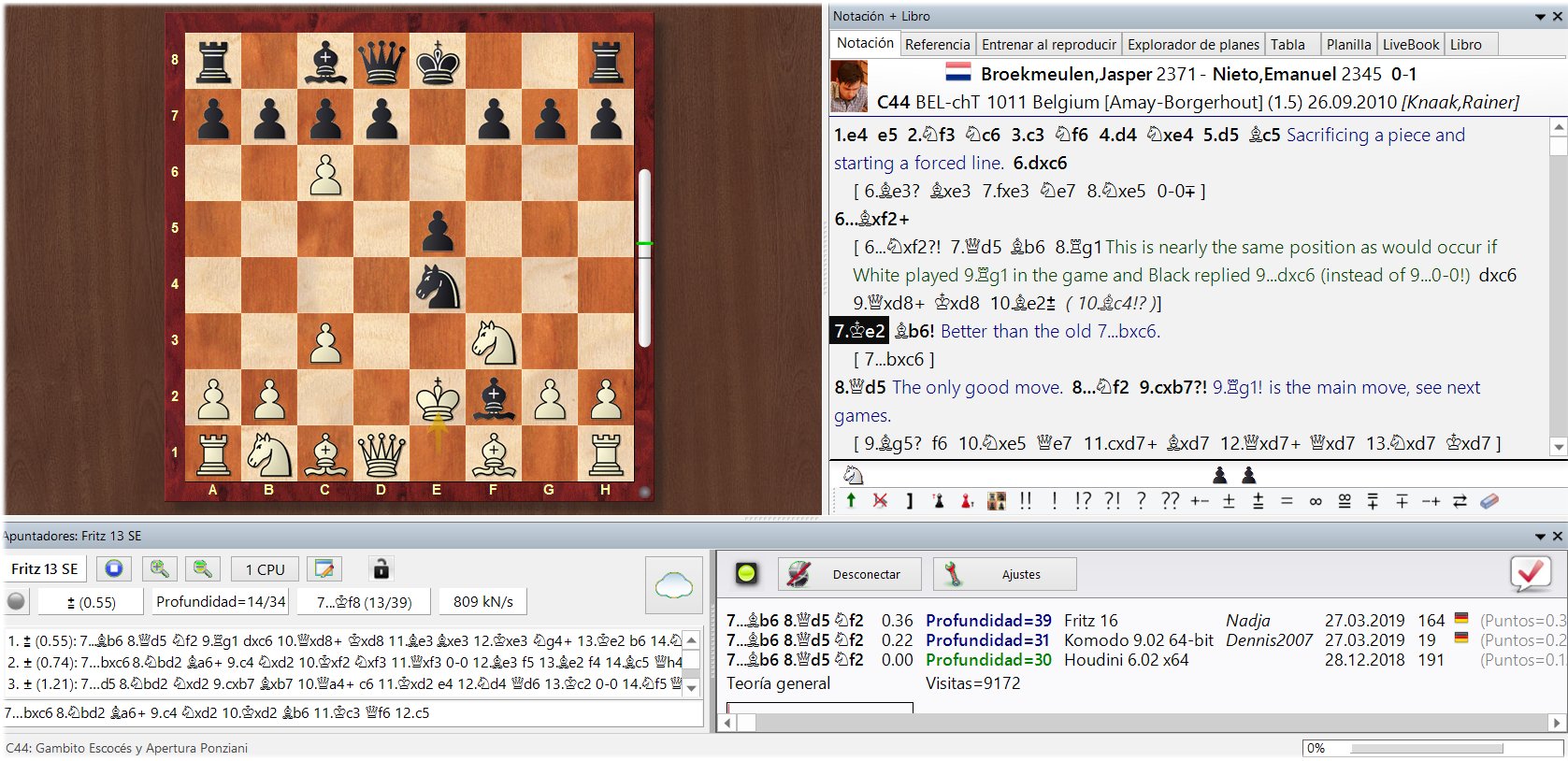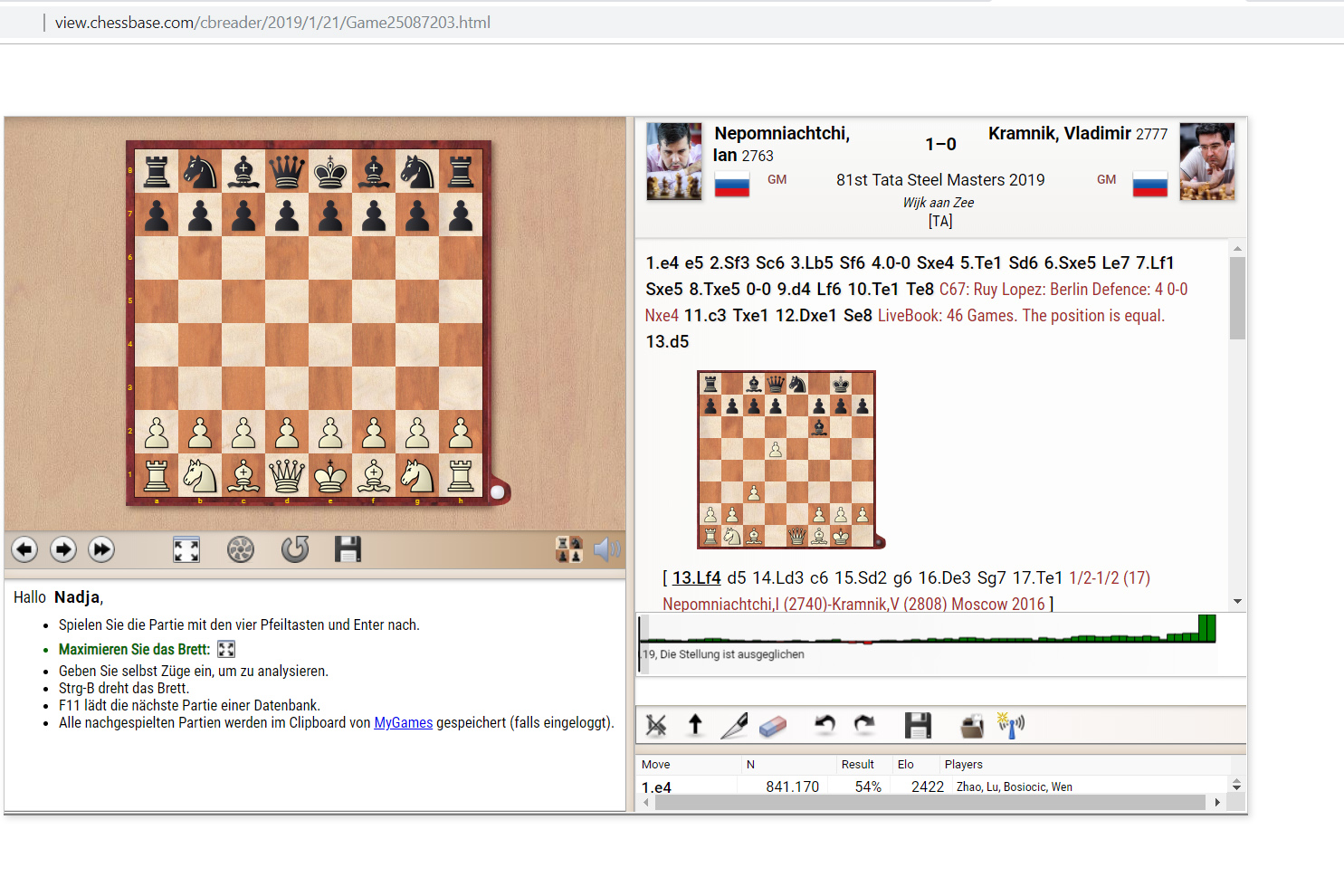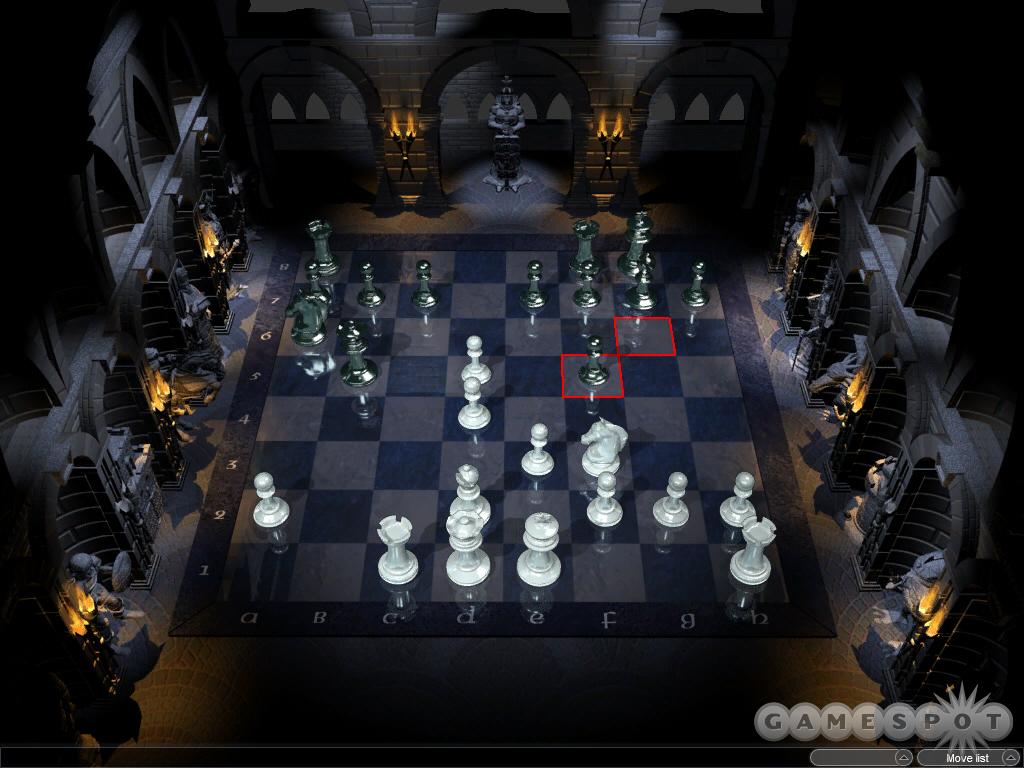- Schach spielen, kiebitzen und trainieren.
- ChessBase Account ACCESS THE WORLD OF CHESSBASE ANYWHERE, ANYTIME - 24/7.
I’ve been using ChessBase for so long as a study and research tool that I often forget how much danged fun it can be. Bear with me as I try to walk you through a tangled labyrinth of seeming random, but closely connected, thoughts.

Chess Training: Play against humans or the chess program Fritz. Watch training videos and live games. Solve tactical positions and maintain your games and openings. ChessBase Workshop columnist Steve Lopez just might have the answer for you with an often-overlooked and certainly underused ChessBase 10 feature. You can learn more about it in the latest Workshop. New: ChessBase 16 - Mega package Edition 2021.
I was thumbing through an old chess strategy book looking for inspiration; I needed a topic for a blog post. My eyes fell upon the old tip that a Bishop pair is often better than a Knight pair in endgames with pawns on both sides of the board. I will definitely use that as material for a blog post — but not today.
While I was using ChessBase 10 to find games in which two Bishops faced off against two Knights in endgames in which there are pawns on both sides of the board, I suddenly realized that a step-by-step tutorial on setting up that ChessBase search would be a great topic of a blog post. It really would be — just not today.
Why not either or those two topics today? Because I ran across a game which really had me scratching my head. I tried to walk away from this game, I really did, but (like Pacino in Godfather III) it just kept pulling me back in. That happens sometimes when you’re using ChessBase 10: you start out headed in one direction but wind up going somewhere else entirely, simply because a game is just that interesting.
Here’s what happened. I launched a search for the aforementioned Bishop pair vs. Knight pair ending, and as I scrolled down the resulting big list of games (about 7,000 of them, which ChessBase found in about ninety seconds), one caught my eye for some odd reason. I think it was the fact that White had the Bishop pair but still lost the game, coupled with the fact that White was a rated 2100+ Master while Black was (apparently) unrated.
You can find tons of games and information in a database, but unless a game is annotated it’s sometimes difficult to know why a game ended as it did. Was one player in time trouble? Was it a late-night round, maybe the last at the end of a very long, busy day? Was he just seeing phantoms? It’s often fun to try to crawl into the heads of the players and try to figure out what the heck was going on.
Now I fully realize that this game was played in a Junior championship, but that doesn’t matter; White’s rated 2103, so I don’t care if he’s four years old — he definitely has some chops. So we really can’t blow this one off due to age; we’ll instead need to really look hard at this game to figure out what happened :
Leal,Joao Vitor (2103) – Esplana Huaman,Christian [E38]

Pan American-ch U16 Matinhos (6), 1999
1.d4 Nf6 2.c4 e6 3.Nc3 Bb4 4.Qc2 c5 5.dxc5 Na6 6.a3 Bxc3+ 7.Qxc3 Nxc5 8.b4 Nce4 9.Qc2 d5 10.f3 Nd6 11.c5 Nf5 12.e3 0-0 13.Bd3 Nh4 14.Bb2 Re8 15.Qf2 Ng6 16.Ne2 e5 17.0-0 Bd7 18.Ng3 b6 19.Nf5 Bxf5 20.Bxf5 bxc5 21.bxc5 Ne7 22.Bd3 Nc6 23.Bb5 Qc7 24.Rac1 Rab8 25.Ba4 Re6 26.Rfd1 Na5 27.Bc3 Nc4 28.e4 dxe4 29.Bb4 Na5 30.fxe4 Nc6
It’s been a see-saw game so far, with neither player holding any great advantage; the players have teetered back and forth on both sides of “dead even” throughout the game up ’til now.
31.Qe1 Rd8
Here’s where it starts getting interesting. White’s big conundrum is to figure out how to exploit his passed pawn; Black has it very well blockaded. Black, on the other hand, needs to keep that c-pawn bottled up, so you’d imagine that he wouldn’t even think about trading material.
32.Bb3
This drives the Black Rook from e6, meaning that it no longer controls d6.
32…Re7 33.Rxd8+
I reckoned that White would play 33.Rd6 here. Now Black can’t play 33…Rxd6 because of 34.cxd6 — a really hideous fork.
33…Qxd8 34.Rd1 Rd7 35.Rd6??
Position after 35.Rd6
And now it’s just plain weird. This move loses the game — it doesn’t work anymore because 35…Rxd6 36.cxd6 doesn’t fork the Black Rook and Queen. If White was going to do this (and I believe it was his intent; he just somehow lost track of why he was doing it), he should have done it a couple of moves ago. If White had instead played 35.Rxd7 Qxd7 he could just offer a draw and everyone could go home. White does have the advantage of the Bishop pair vs. the Knight pair, but it’s hard to picture either player making any real progress without a protracted struggle and/or a helpful blunder.
35…Rxd6 36.cxd6
See? This is what I don’t understand about White’s thinking. Yes, the c-pawn has now become a d-pawn and has managed to “end run” the blockading Knight, but Black’s Knights control both d7 and d8, so no promotion is in the pawn’s immediate future. Furthermore Black’s Queen is now a free agent while White’s Queen is presently tied to the defense of the e4-pawn.
36…Qb6+ 37.Qf2 Qxf2+ 38.Kxf2 Nxb4
Nice. Black trades a Knight for a pesky Bishop. If 38…Nxe4+ 39.Ke3 Nxd6 40.Bxd6 Nd4 41.Bxf7+ Kxf7 42.Ke4 Ke6 43.Bxe5 it’s dead even, although White is theoretically better because of his Bishop.
39.d7??
White should have played 39.axb4. After 39…Nxe4+ it’s still a mess, but my money’s on Black’s extra pawn and his Kingside pawn majority eventually winning the day, although White still has the chance to go down swinging.
39…Nc6 0-1
White just lost a minor piece for nothing and his passed pawn is going next, so he quits on the spot. It’s just amazing to me how even a master-level player can find a good idea, then become so fixated on it (as I presume happened here) that he fails to notice that a changed game condition renders the original idea null and void.
Perhaps you can understand now why this blog post ended up so far removed from my original intent for it. This game really captivated me and I wanted to share it with you. It’s interesting to note again that you can find plenty of games in using a “data mining” chess program like ChessBase 10, but it’s not always possible to understand why a game is played a particular way unless you really take some time with it (as I did here) and try to figure out what a player was thinking in a given critical position.
As I said earlier, I was able to find more than 7,000 games (from a database of over 4,000,000) which matched my search criteria, and did it in about ninety seconds using ChessBase 10. Get more from your chess study time using ChessBase 10, available now from ChessCentral, the leader in cutting-edge chess.
Have fun! — Steve
Filed under: Chess instruction, Chess Software, Other Chess Information | Tagged: annotated chess game, Bishop vs Knight endgame, chess, chess advice, chess database, chess endgame, chess improvement, Chess instruction, chess products, chess program, Chess Software, chess tips, chess training, chessbase, ChessBase 10, chesscentral, Steve Lopez | 1 Comment »
I’ve been using ChessBase for so long as a study and research tool that I often forget how much danged fun it can be. Bear with me as I try to walk you through a tangled labyrinth of seeming random, but closely connected, thoughts.
I was thumbing through an old chess strategy book looking for inspiration; I needed a topic for a blog post. My eyes fell upon the old tip that a Bishop pair is often better than a Knight pair in endgames with pawns on both sides of the board. I will definitely use that as material for a blog post — but not today.

While I was using ChessBase 10 to find games in which two Bishops faced off against two Knights in endgames in which there are pawns on both sides of the board, I suddenly realized that a step-by-step tutorial on setting up that ChessBase search would be a great topic of a blog post. It really would be — just not today.
Why not either or those two topics today? Because I ran across a game which really had me scratching my head. I tried to walk away from this game, I really did, but (like Pacino in Godfather III) it just kept pulling me back in. That happens sometimes when you’re using ChessBase 10: you start out headed in one direction but wind up going somewhere else entirely, simply because a game is just that interesting.
Here’s what happened. I launched a search for the aforementioned Bishop pair vs. Knight pair ending, and as I scrolled down the resulting big list of games (about 7,000 of them, which ChessBase found in about ninety seconds), one caught my eye for some odd reason. I think it was the fact that White had the Bishop pair but still lost the game, coupled with the fact that White was a rated 2100+ Master while Black was (apparently) unrated.
You can find tons of games and information in a database, but unless a game is annotated it’s sometimes difficult to know why a game ended as it did. Was one player in time trouble? Was it a late-night round, maybe the last at the end of a very long, busy day? Was he just seeing phantoms? It’s often fun to try to crawl into the heads of the players and try to figure out what the heck was going on.
Now I fully realize that this game was played in a Junior championship, but that doesn’t matter; White’s rated 2103, so I don’t care if he’s four years old — he definitely has some chops. So we really can’t blow this one off due to age; we’ll instead need to really look hard at this game to figure out what happened :
Leal,Joao Vitor (2103) – Esplana Huaman,Christian [E38]
Pan American-ch U16 Matinhos (6), 1999
1.d4 Nf6 2.c4 e6 3.Nc3 Bb4 4.Qc2 c5 5.dxc5 Na6 6.a3 Bxc3+ 7.Qxc3 Nxc5 8.b4 Nce4 9.Qc2 d5 10.f3 Nd6 11.c5 Nf5 12.e3 0-0 13.Bd3 Nh4 14.Bb2 Re8 15.Qf2 Ng6 16.Ne2 e5 17.0-0 Bd7 18.Ng3 b6 19.Nf5 Bxf5 20.Bxf5 bxc5 21.bxc5 Ne7 22.Bd3 Nc6 23.Bb5 Qc7 24.Rac1 Rab8 25.Ba4 Re6 26.Rfd1 Na5 27.Bc3 Nc4 28.e4 dxe4 29.Bb4 Na5 30.fxe4 Nc6
It’s been a see-saw game so far, with neither player holding any great advantage; the players have teetered back and forth on both sides of “dead even” throughout the game up ’til now.
31.Qe1 Rd8
Here’s where it starts getting interesting. White’s big conundrum is to figure out how to exploit his passed pawn; Black has it very well blockaded. Black, on the other hand, needs to keep that c-pawn bottled up, so you’d imagine that he wouldn’t even think about trading material.
32.Bb3
This drives the Black Rook from e6, meaning that it no longer controls d6.
32…Re7 33.Rxd8+
I reckoned that White would play 33.Rd6 here. Now Black can’t play 33…Rxd6 because of 34.cxd6 — a really hideous fork.
33…Qxd8 34.Rd1 Rd7 35.Rd6??
Position after 35.Rd6
And now it’s just plain weird. This move loses the game — it doesn’t work anymore because 35…Rxd6 36.cxd6 doesn’t fork the Black Rook and Queen. If White was going to do this (and I believe it was his intent; he just somehow lost track of why he was doing it), he should have done it a couple of moves ago. If White had instead played 35.Rxd7 Qxd7 he could just offer a draw and everyone could go home. White does have the advantage of the Bishop pair vs. the Knight pair, but it’s hard to picture either player making any real progress without a protracted struggle and/or a helpful blunder.
Chessbase Reader Windows 10
35…Rxd6 36.cxd6
Chessbase 10 Release
See? This is what I don’t understand about White’s thinking. Yes, the c-pawn has now become a d-pawn and has managed to “end run” the blockading Knight, but Black’s Knights control both d7 and d8, so no promotion is in the pawn’s immediate future. Furthermore Black’s Queen is now a free agent while White’s Queen is presently tied to the defense of the e4-pawn.
36…Qb6+ 37.Qf2 Qxf2+ 38.Kxf2 Nxb4
Nice. Black trades a Knight for a pesky Bishop. If 38…Nxe4+ 39.Ke3 Nxd6 40.Bxd6 Nd4 41.Bxf7+ Kxf7 42.Ke4 Ke6 43.Bxe5 it’s dead even, although White is theoretically better because of his Bishop.
39.d7??

White should have played 39.axb4. After 39…Nxe4+ it’s still a mess, but my money’s on Black’s extra pawn and his Kingside pawn majority eventually winning the day, although White still has the chance to go down swinging.
39…Nc6 0-1
White just lost a minor piece for nothing and his passed pawn is going next, so he quits on the spot. It’s just amazing to me how even a master-level player can find a good idea, then become so fixated on it (as I presume happened here) that he fails to notice that a changed game condition renders the original idea null and void.
Perhaps you can understand now why this blog post ended up so far removed from my original intent for it. This game really captivated me and I wanted to share it with you. It’s interesting to note again that you can find plenty of games in using a “data mining” chess program like ChessBase 10, but it’s not always possible to understand why a game is played a particular way unless you really take some time with it (as I did here) and try to figure out what a player was thinking in a given critical position.
As I said earlier, I was able to find more than 7,000 games (from a database of over 4,000,000) which matched my search criteria, and did it in about ninety seconds using ChessBase 10. Get more from your chess study time using ChessBase 10, available now from ChessCentral, the leader in cutting-edge chess.

Have fun! — Steve
Filed under: Chess instruction, Chess Software, Other Chess Information | Tagged: annotated chess game, Bishop vs Knight endgame, chess, chess advice, chess database, chess endgame, chess improvement, Chess instruction, chess products, chess program, Chess Software, chess tips, chess training, chessbase, ChessBase 10, chesscentral, Steve Lopez | 1 Comment »